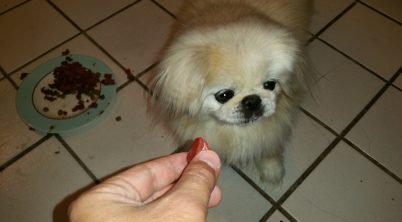The Pekingese, a toy breed with ancient Chinese heritage, is often recognized by its luxurious coat that comes in various colors and lion-like appearance, lending it the nickname “Lion Dog.” Originating from the ancient city of Peking (now Beijing), this breed has a regal history, once revered by Chinese emperors. Despite its small size, the Pekingese packs a bold and confident personality, traits that have defined its temperament across centuries. As a family dog, the Pekingese is known to form strong attachments, often gravitating towards a particular favourite person in the household, embodying the typical nature of a devoted lapdog.
When considering the Pekingese’s friendliness towards other dogs, one must take into account their spirited temperament. They can display a noble and somewhat aloof demeanor, not unlike their imperial forebears, which might affect their interactions with other breeds. However, with appropriate socialization starting at an early age, a Pekingese can learn to coexist and even enjoy the company of other dogs. Their compatibility with other pets, such as cats, largely depends on their individual personality and the early experiences they have with these animals.
Potential owners should be attentive to the health aspects and care requirements of the Pekingese. Their thick double coat necessitates regular grooming to prevent matting and to maintain their distinctive appearance. Health issues, such as brachycephalic syndrome due to their short muzzles, and diet considerations are also crucial aspects of Pekingese care. Despite these considerations, for those willing to invest in proper care and training, the Pekingese can be a friendly and affectionate member of the family, often delighting in the companionship it provides within its familiar social group.
Table of Contents
Are Pekingese Friendly With Other Dogs?
Pekingese dogs, known for their distinctive appearance with a lion-like mane and compact body, weigh between 7 to 14 pounds and generally stand about 6 to 9 inches at the shoulder. They are characterized by their brachycephalic face, long, luxurious coat which requires regular grooming, and come in various colors.
In terms of temperament, Pekingese are affectionate and loyal to their families, but their interactions with other dogs can vary. These dogs are independent and can be stubborn, traits that may influence their sociability. Early and thorough socialization is crucial to help Pekingese get along with other dogs. Without it, they may remain aloof or indifferent around their canine counterparts.
The Pekingese are known for their alert nature, which may lead to aggressive behavior if they feel threatened by other dogs. However, when properly introduced and socialized, they can coexist peacefully with other pets. It’s important to understand that they may not exhibit the playfulness or exercise needs of some other breeds due to their calm demeanor, which may affect interactions with more energetic dogs.
It’s also worth considering Pekingese health problems, such as breathing issues due to their flat faces, which could impact their playfulness with other dogs. Regular check-ups, adequate nutrition, and managing their exercise needs are essential to maintain their wellbeing throughout their typically long lifespan of up to 15 years.
Owners should always monitor their Pekingese when they are with other dogs to ensure interactions are positive and that their unique characteristics aren’t leading to stress or discomfort, which can be indicated by excessive shedding.
Pekingese and Socialization
A Pekingese’s ability to form harmonious relationships with other pets and humans largely depends on its early socialization experiences. These toy breeds, historically kept as dignified companions in royal courts, retain a strong sense of loyalty and individualism that can influence their interactions with others.
Behavior With Other Pets
Pekingese may display reserve around other animals, but early and consistent socialization can enhance their friendliness. They can coexist peacefully with other family pets if they are raised together or introduced properly. However, due to their strong watchdog instincts, Pekingese might show territorial behavior toward unfamiliar animals. When socializing a Pekingese with other pets, consider the following:
- Introduce pets gradually: Short, supervised meetings that progressively increase in length can prevent overwhelm.
- Positive reinforcement: Reward calm and sociable behaviors to reinforce these actions.
- Consistent training: Regular training sessions help Pekingese understand expected behaviors around other animals.
Interacting With Humans
These confident little dogs are known for their loyalty and can be quite affectionate with family members. Pekingese possess a dignified nature, which often translates to a discerning attitude towards strangers. They are not typically regarded as traditional family dogs due to their sometimes guarded disposition; however, they do form strong bonds with those they are close to. Here’s how to foster a Pekingese’s human interactions:
- Socialization with various people: Expose them to different individuals from a young age to boost their sociability.
- Supervision with children: Children should be taught how to interact gently and respectfully with a Pekingese, as this breed may not tolerate rough handling.
- Training for companionship roles: Regular training enhances the Pekingese’s natural aptitude for companionship, fostering good behavior around humans.
Overall, the Pekingese requires attention and companionship from their humans, thriving on being an integral part of the household. Their trainability and adaptability can make them amenable to life with other pets and people when properly socialized.
Training and Exercise
When it comes to training a Pekingese, owners should approach the process with a clear and patient mindset. They are intelligent but can exhibit stubborn and independent behaviors. Consistent positive reinforcement is key—rewarding good behavior with treats or praise encourages a Pekingese to follow commands.
Exercise Needs:
- Energy Level: Moderate
- Activity: Daily walks and play sessions
- Exercise Requirements: Up to 30 minutes per day
Training should start early, focusing on socialization to help Pekingese adapt to various environments and other dogs. They typically respond well to behavioral training, such as housetraining, when it begins at a young age. Obedience classes are beneficial, not just for commands but also for social activity, which is crucial given their typically regal temperament.
Pekingese don’t require extensive exercise but do need regular activity to maintain their health. Daily moderate walks and free play can meet their exercise needs and prevent boredom. Their energy level isn’t high, so activities should match their pace without overexertion, due to their compact respiratory system.
Training Table:
| Aspect | Strategy | Notes |
|---|---|---|
| Trainability | Start early, be patient, use positive reinforcement | Can be stubborn; need consistent positive motivation |
| Exercise Routine | Daily walks, playtime | Avoid strenuous activity; pay attention to their breathing |
| Behavior Management | Socialization, obedience classes | Helps prevent territorial or aloof behavior |
Lastly, it’s important to recognize their smart and curious nature during training sessions. They may seem resistant at times, but with a confident and adaptable training approach, a Pekingese can be a delightful and well-exercised companion.
Adoption and Ownership
When considering the adoption or ownership of a Pekingese, prospective pet parents must recognize the breed’s characteristics to ensure they can provide a suitable home. Pekingese dogs are renowned for their loyalty and compact size, making them ideal companions for various living situations, including apartments.
Sizes and Colors:
- Size: Typically compact and small, ideal for limited space.
- Colors: Can include tan, red, black, white, cream, and gray, allowing for personal preference.
Pekingese dogs are known to be somewhat lapdog in nature, often content to be close to their owners. However, they do require adequate space to move and play. They thrive on attention and interaction, being one of the more loyal breeds.
Acquisition:
- Adopt: Adopting a Pekingese can cost around $300, a fee that supports the care given before adoption.
- Purchase: Buying from a reputable breeder can vary substantially in cost, from $800 to $3,000.
Considerations for Potential Owners:
- Diet: Pay attention to their dietary needs to maintain their health and coat condition.
- Size and space: Ensure there is enough room for them to be comfortable as they enjoy being in close proximity to their owners.
It’s important to note that Pekingese can come in various colors; regardless of the color, they require regular grooming. Those considering owning a Pekingese should research and possibly meet the breed in person to fully understand the responsibility of caring for these animals. Adoption from shelters or rescue networks offers the chance to offer a home to a dog in need. Whether adopting or purchasing from a breeder, it’s crucial to commit to providing a loving, stable environment for the Pekingese, thereby honoring their tradition of companionship.
* Banner photo by Seongbin Im, cropped | Some rights reserved








